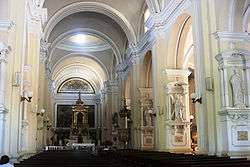León Cathedral (Nicaragua)
| Cathedral of the Assumption of Mary of León Catedral de la Asuncíon de María de León (Spanish) | |
|---|---|
|
| |
| Basic information | |
| Location | León, Nicaragua |
| Geographic coordinates | 12°26′6″N 86°52′41″W / 12.43500°N 86.87806°WCoordinates: 12°26′6″N 86°52′41″W / 12.43500°N 86.87806°W |
| Affiliation | Roman Catholic |
| Province | Diocese of León |
| Year consecrated | 1860 |
| Architectural description | |
| Architectural style | Neoclassical |
| Groundbreaking | 1747 |
| Completed | 1814 |
| Official name: Cathedral of León | |
| Type | Cultural |
| Criteria | ii, iv |
| Designated | 2011 (35th session) |
| Reference no. | 1236 |
| State Party |
|
| Region | Latin America and the Caribbean |

The Cathedral of León, also known as the "Real and Renowned Basilica Cathedral of the Assumption of the Blessed Virgin Mary"(Spanish: Real e Insigne Basílica de la Asunción de la Bienaventurada Virgen María), is a significantly important and historic landmark in Nicaragua. The Cathedral was awarded World Heritage Site status with the United Nations Educational, Scientific and Cultural Organization (UNESCO). The site's nomination is Nicaragua's third cultural landmark, following the ruins of León Viejo and El Güegüense .
Construction
The Cathedral's construction lasted between 1747 and 1814 and was consecrated by Pope Pius IX in 1860. Cathedral has maintained the status of being the largest cathedral in Central America and one of the best known in the Americas due to its distinct architecture and special cultural importance.
Architecture
The architectural design was developed in 1762 by the Guatemalan architect Diego José de Porres y Esquivel. It blends the Baroque and Neoclassicism styles with some influences from Gothic, Renaissance and Mudejar styles. Thus the building can be categorized as belonging to the Eclecticism style.[1] The cathedral has a rectangular plan, of a type general in those centuries and similar to those of the cathedrals of Lima and Cuzco, Peru. The towers and the facade are mainly Neoclassical. The cathedral has a nave and four aisles, ten arched bays and two towers in the facade, flanking a central round pediment marking the position of the nave. The sacrarium, whose salient breaks the rectangular symmetry of the building on the South side, is located almost parallel to the biggest altar. Their interior is roomy and its columns cruciform; the central nave is divided by columns from the lateral aisles and the structure is finished off over the crossing by a great dome. The facade, elevated on a terrace, combines Baroque show with the neoclassical style. The windows are arched and the two towers have Chinese domes. Due to the robustness of its walls, the Cathedral has survived tremors, volcanic eruptions of the volcano Black Hill and wars.
Seven tunnels start under the church and lead to the other churches in the city. [1]
Historical value
The Cathedral has the historical value of being the Episcopal first diocese of the Catholic Church in Nicaragua, founded in 1531 and therefore one of the oldest dioceses in America. It is currently the headquarters of the Diócesis of León.
Beneath the Cathedral, in crypts designed to survive earthquakes, the mortal remains of 27 people rest, among them 10 bishops, 5 priests, an eminent leader of the independence movement, three poets, a musician, six notables and a slave.
Here are buried prominent Nicaraguan people, such as Miguel Larreynaga, poets Rubén Darío, Salomón de la Selva and Alfonso Cortés, the musician José de la Cruz Mena, doctor Luis H. Debayle, professor Edgardo Buitrago, the first bishop of León and last bishop of all of Nicaragua, Monsignor Simeón Pereira, and Bishop Castellón and the priest Marcelino Areas.
The tomb of Darío, father of the Modernist movement in Spanish-language literature and considered Prince of Castilian letters, is to the foot of the statue of San Pablo.
At the beginning of the 20th century, the Bishop, Monsignor Simón Pereira y Castellón (the same who presided over the funeral of Darío the February 13 of 1916) commissioned the Granadan sculptor Jorge Navas Cordonero to make the statue of the Virgin María crowning the central pediment of the facade, and the Atlantes between the pediment and the towers. Navas also sculpted the Neoclassical statues of the Twelve Apostles next to the columns of the central nave, the león of Dario's tomb, very similar to the Lion of Lucerne, Switzerland (carved by the Danish sculptor Bertel Thorvaldsen, 1770–1844), the sculpture of Christ marking Monsignor Pereira's tomb, and several other decorations inside the Cathedral and its Chapel of the Sacrarium.
References
- 1 2 "Cathedral of the Assumption, León". Wondermondo.